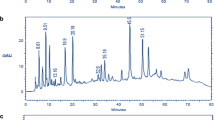Abstract
Inhibitory activity of the three major triterpenes from the stems of Cynomorium songaricum—ursolic acid, acetyl ursolic acid, and malonyl ursolic acid hemiester—and their related compounds were tested for their inhibitory activity on HCV protease; malonyl ursolic acid hemiester was the most potent. A HPLC–PAD (photo diode array detector)–MS method was established to quantify the contents of each triterpene in C. songaricum. Using this method, the effect heating had on the contents was also investigated. It was found that among the three triterpenes, the content of malonyl ursolic acid hemiester decreased most quickly during the heating process.


Similar content being viewed by others
References
State Administration of Traditional Chinese Medicine of People’s Republic of China (1999) Zhong Hua Ben Cao, vol 5. Shanghai Science and Technology Press, Shanghai, pp 722–724
Jiang ZH, Tanaka T, Sakamoto M, Jiang T, Kouno I (2001) Studies on a medicinal parasitic plant: lignans from the stems of Cynomorium songaricum. Chem Pharm Bull 49:1036–1038
Ma CM, Nakamura N, Miyashiro H, Hattori M, Shimotohno K (1999) Inhibitory effects of constituents from Cynomorium songaricum and related triterpene derivatives on HIV-1 protease. Chem Pharm Bull 47:141–145
Chu QC, Tian XH, Lin M, Ye JN (2006) Electromigration profiles of Cynomorium songaricum based on capillary electrophoresis with amperometric detection. J Agric Food Chem 54:7979–7983
Zhang CZ, Xu XZ, Li C (1996) Fructosides from Cynomorium songaricum. Phytochemistry 41:975–976
Ma CM, Jia SS, Sun T, Zhang YW (1993) Triterpenes and steroidal compounds from Cynomorium songaricum. Yaoxue Xuebao 28:152–155
Zhang SZ, Zhang SY (1991) Chemical constituents of Cynomorium songaricum. Zhongguo Yaoxue Zazhi 26:649–651
Di DL, Liu YW, Mao XC, Chen JW (2004) Determination of ursolic acid in Cynomorium songaricum by RP-HPLC. Zhongguo Yiyuan Yaoxue Zazhi 24:730–732
Ding HW, Wang Y, Wang SY, You WX (1998) Quantitative determination of ursolic acid in Herba Cynomorium songaricum Rupr. by ultraviolet spectrophotometry. Zhongguo Zhongyao Zazhi 23:102–103
Hussein G, Nakamura N, Hattori M, Kakiuchi N, Shimotohno K (2000) Inhibitory effects of Sudanese medicinal plant extracts on hepatitis C virus (HCV) protease. Phytother Res 14:510–516
Author information
Authors and Affiliations
Corresponding author
Rights and permissions
About this article
Cite this article
Ma, CM., Wei, Y., Wang, ZG. et al. Triterpenes from Cynomorium songaricium—analysis of HCV protease inhibitory activity, quantification, and content change under the influence of heating. J Nat Med 63, 9–14 (2009). https://doi.org/10.1007/s11418-008-0267-7
Received:
Accepted:
Published:
Issue Date:
DOI: https://doi.org/10.1007/s11418-008-0267-7




